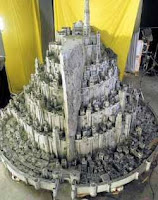'Nothing makes a model look less convincing then too much detail on distant objects.'


Painting a model miniature adds the finishing touches to it and is very important in making the model appear realistic and giving it character. The model has to be painted to represent the materials it would be constructed from in reality. So if the model is made from plaster different elements of it may have to be painted to look like wood or metal for example to make the building look authentic.
Ageing and weathering is also a vital part of creating an authentic looking model, as everything, especially buildings are affected by the elements of rain, wind, sun etc.
Picture below, model used in X Files: The Movie (1998) Miniature was made pre-destroyed.

A couple of months ago I came across a process called Tilt-Shift photography, which is a perfect example of how important depth of field can be in relation to creating the illusion of scale. The Tilt-Shift process involves manipulating photographs of life sized objects or locations to make them look as though they are miniature scale models. Click on the link below to have a look at the results and some examples of this technique. http://www.tiltshiftphotography.net/
